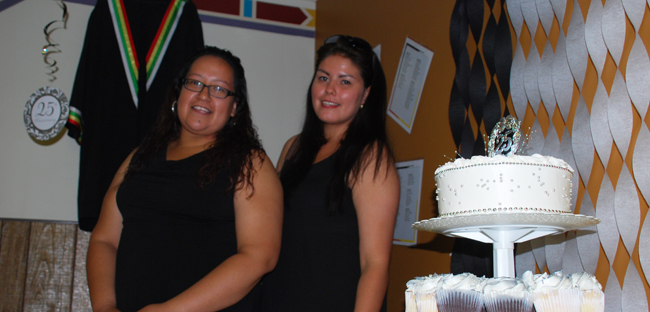Alternative Legacy: 25 years of creating high school grads

By Laura E. Young
SUDBURY – The hope had been to release butterflies at the N’Swakomak Friendship Centre Alternative School graduation in June.
But the butterflies they had raised from the larva stage had a scant, two-week lifespan and weren’t going to last. The science lesson became more, recalls Kelly-Lee Assinewe, coordinator of the Alternative School. The grads didn’t want to release their butterflies early, she recalls.
“There were a whole bunch of lessons about life in general, life journeys, caring for something. It was people coming together, working together as a team. That goes beyond just the classroom.”
That kind of thinking outside the box is behind the success of the Alternative School which celebrated its 25th anniversary reunion on June 13.
For many students, the school – and by extension the Friendship Centre – became their safe place, a fact that alternately saddens and pleases Assinewe. “It does make me feel good that they feel comfortable here, that we have created that caring and supportive environment that they can feel safe.”
Morgan Stephens was 19 and had been out of high school when she had an opportunity to come to the alternative school and earn her high school diploma in 2011. She was also class valedictorian. “With Kelly-Lee pushing you really hard to the max, that’s what you need. They are more involved with the students,” says the mother of two who will start her training as a heavy equipment technician in September at Cambrian College.
Maggie Faries was 21 and already a mother when she came to the alternative school. “When you walked in you felt comfortable. Kelly-Lee was always there to push us and phone us, ‘Are you coming to school.’”
Faries graduated in 2010 and was also class valedictorian. Now a mother of three, she is studying pre-health at Cambrian with plans to enter the nursing program.
Faries and Stephens became friends through the alternative school. Their lives are hectic and busy but “we’re going to Cambrian and get it done,” Morgan adds. The kids are their motivators. “We want a way better life for them than we had,” they say.
In 1990, the overall drop out rate of Native students was four times that of the national average. Assinewe recalls how Ontario’s Friendship Centres recognized something really needed to be done to stem the tide. In 1990, three pilot projects were launched in friendship centres in Sudbury, London, and Fort Erie. N’Swakamok Centre was the first.
Joe Drago, then principal at nearby Sudbury Secondary School, became the school’s first principal. He had never had one Native student go to university, he says.
It was key to hire Assinewe. The teachers and guidance counsellors were committed, he recalls. “We had kids integrating when they felt comfortable, and (they became) involved in school activities, making them feel they could succeed in a so-called white atmosphere.”
In Sudbury, the students range in age from 16 to 40; in one class, a 65-year-old mother graduated. In 2015, there were 12 graduates: 10 will head to post-secondary in September, mainly at Sudbury’s Cambrian College. The slim majority of students is female, a 60-40 split.
There is day care available as well as a light breakfast and a lunch program.
There are now 11 alternative-like schools across Ontario serving about 1,000 students

